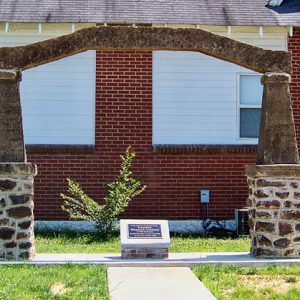calsfoundation@cals.org
Maynard Baptist Academy
aka: Abbott Institute
aka: Ouachita Baptist Academy
The Maynard Baptist Academy—first known as the Abbott Institute and then as the Ouachita Baptist Academy—was a boarding school founded in 1894 in Maynard (Randolph County). At the time, most schools typically had only one room and went only as far as the eighth grade.
The Abbott Institute was founded in 1894 by the Abbott (or Abbot) family from the Maynard area. While they themselves lacked much education, they saw great value in educating the young people of the area and surrounding areas. Eli Abbott had been very successful in land speculation in the Fourche River and Current River bottomland while also farming. The institute drew students from a wide area of Arkansas and from other states. The school had a dormitory for young women; male students were expected to find accommodations with local families.
At this time, the Baptist churches of Arkansas were seeking to build schools in areas with a mild climate and less chance of disease. Maynard was a good location for such a school, as its location was far enough away from the river bottoms, which were home to disease-spreading mosquitoes. In fact, advertisements from the period described Maynard as being far away from the “death-lurking swamps.” The Abbott Institute became part of a network of schools associated with what is today Ouachita Baptist University (OBU) in Arkadelphia (Clark County), though there is some confusion about when this association began.
The school began in the ninth grade and offered civics, history, English, Latin, Bible, science, and algebra. It also offered teaching of arithmetic, since many of the students aimed to take the state teachers’ exam and teach in local one-room schools upon graduation. It also featured extracurricular activities for students, such as basketball, baseball, and the Aurora Literary Society.
Since this was a private, religious school, students had to pay tuition in order to attend. For the ninth grade, the tuition was $3.50 per month, and those costs increased by fifty cents for the succeeding years. Students who were not from the Maynard area also had to pay boarding charges. Students also had to pay an extra $4.00 per month in order to participate in extra-curricular activities and a $1.00 enrollment fee. In a typical month, a student could spend $20.00 to $25.00 for all fees, making the academy expensive by turn-of-the-century standards. In 1903, the school had an enrollment of seventy-eight students.
Arkansas underwent one of its first major educational reforms in the mid-to-late 1920s. As the state began consolidating smaller schools and developing high schools paid for by property taxes, schools like the academy lost much of their niche market. In 1928, the Maynard Baptist Academy was sold to the Maynard Public School District, and its facilities were used by the public school. Today, all that is left of the academy is the arch that the last class built in 1927. In 2008, the Maynard School Alumni Association restored this arch on the school grounds as a memorial to the academy.
For additional information:
Cook, Regina, et al. History of Randolph County, Arkansas. Dallas: Curtis Media Corp., 1992.
Dalton, Lawrence. The History of Randolph County. Little Rock: Democrat Printing and Lithographing Company, 1946.
Seawel, Harmon, and Susan Seawel. From Ox Teams to Computer Chips: A History of the Maynard Community, 1800–1995. N.p.: 1995.
Rodney Harris
Pocahontas, Arkansas
 Mountain Mission Schools
Mountain Mission Schools Abbott Institute Arch
Abbott Institute Arch 



I was born in Reyno, Arkansas, and my grandmother, Anna Nelson, and her sister, Myrtle Nelson, were sent there to school.